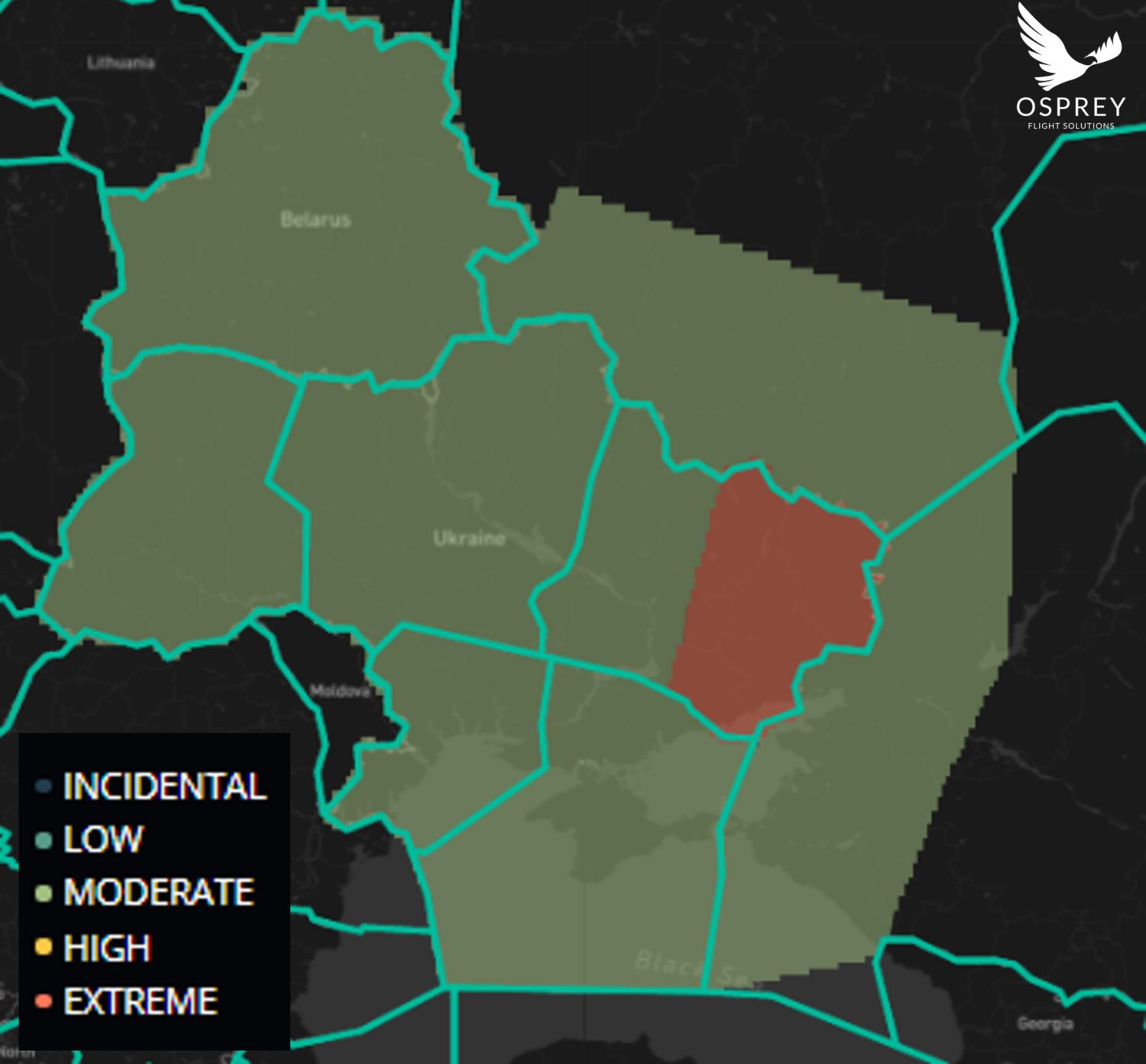Introduction
Tensions have been rising between Ukraine and Russia in the past month over Russian military deployments into Crimea (in FIR Simferopol (UKFV)), as well as to the Voronezh oblast (in FIR Moscow (UUWV)), Rostov oblast and Krasnodar krai (each in FIR Rostov (URRV)), located adjacent to the eastern Ukrainian regions of Donetsk and Luhansk. The Russian Southern Military District includes the Rostov, Krasnodar and Crimea areas while Voronezh is in the Central Military District. During September, the Russian Ministry of Defence announced that the Central & Southern Military Districts had participated in the Zapad-21 exercise involving tens of thousands of personnel and dozens of battalion-sized tactical groups; this included electronic warfare (EW) units and air-defence batteries for counter-drone training. Similar Russian military exercise activity occurred in April of this year in the Central & Southern Military Districts, and many of the forces involved in the above activity remained in the area after the drills had ended.

The US, UK, EU and NATO have all made statements in support of Ukraine and called on Russia to avoid escalating the situation along the border. Meanwhile, Russia has accused Ukraine of inflaming the conflict in Donetsk and Luhansk while accusing NATO of conducting increased levels of air and naval activity in the Black Sea in the past month. The airspace operational situation over portions of Ukraine, Russia and the Black Sea remains fluid and subject to rapid change.
Regulatory Information
Previously, on 17 April, the US FAA issued a NOTAM advising US-registered operators to use “extreme caution” when conducting flights in Russia’s FIR Moscow (UUWV) and FIR Rostov (URRV) within 100NM of Ukraine’s FIR Dnipro (UKDV), FIR Simferopol (UKFV) and FIR Kyiv (UKBV) (KICZ A0012/21). The FAA NOTAM references “potential safety-of-flight risks associated with escalating regional tensions between Russia and Ukraine, which could potentially result in no-notice cross-border skirmishes, increased military activities and/or conflict”.
In addition, unannounced military air activity and airspace control issues in FIR Simferopol (UKFV) over the Black Sea represent ongoing civil aviation safety-of-flight concerns, as evidenced by advisories issued by the UK and French civil aviation authorities (France AIC – A 18/21, UK AIP ENR 1.1 Section 1.4).
EASA along with the US, UK, Canadian and French civil aviation authorities have also issued strict guidance to operators in the past two years, advising all flights be deferred within the airspace over Donetsk and Luhansk provinces. For full details of these notices, please access Osprey:Open via the following link: https://open.ospreyfs.net
The Data – Russia & Ukraine

The above visualisation shows rocket, mortar and artillery fire in eastern Ukraine between April 2018 and November 2021. The data indicates that such activity in July-November is in line with the first half of 2021 and well below levels observed in 2019.

The graph above represents conventional military activity and conflict zone dynamics within Ukraine between 2018 through 2021. The data indicates that such activity in April-November 2021 is elevated compared with the previous nine months but is below levels observed in the first half of 2019.

The visualisation above shows conventional military activity within Russia between 2018 and 2021. The data indicates that there have been spikes in such activity in April and November 2021; however, similar levels were observed in the summer of 2020.

The above graph shows conventional military activity within Russia and Ukraine between 2018 and 2021. The data indicates that there have been spikes in such activity in April and November 2021; however, similar monthly average levels were observed in June-October 2020.
Outlook
While the true intentions of the Russians and the Ukrainians are opaque, Osprey Flight Solutions continues to view much of the activity as posturing by both sides and heightened levels of military training, which are occurring in concert with complex diplomatic engagements. Some of the traditional media reporting on the situation in eastern Ukraine and along the Ukrainian-Russian border has overstated the size and scope of military activity occurring within these areas. Divisive public statements by officials from the Russian, Ukrainian and Western governments have also played a notable part in inflaming tensions. Below is Osprey Flight Solutions’ assessment of the situation:
- Russia has military airbases with combat aircraft and air-defence units with conventional surface-to-air missile (SAM) systems operationally stationed in areas of Crimea, as well as Voronezh, Rostov and Krasnodar. The Ukrainian military has similar capabilities within its borders. The SAM systems and combat aircraft are capable of engaging targets at altitudes well above FL260. However, there are no indications that Russia or Ukraine intends to kinetically target legal civil aviation flights.
- We assess unsafe air-defence activity will persist multiple times per week in the airspace over the Donetsk and Luhansk regions in the long term until a comprehensive peace resolution between the factions in the eastern Ukraine conflict is reached. We do not assess such a reconciliation will be reached within the next six months.
- GPS interference stemming from EW system use by military forces is assessed to be the primary issue operators may face outside Donetsk and Luhansk in areas of Ukraine’s FIR Dnipro (UKDV), FIR Simferopol (UKFV), FIR Kyiv (UKBV) and UIR Kyiv (UKBU) as well as in Russia’s FIR Moscow (UUWV) and FIR Rostov (URRV). However, should tensions between Russia and Ukraine over Donetsk and Luhansk provinces and/or Crimea escalate further, more restrictive measures could be enacted at short notice, including additional partial or full closures of airspace in the above FIRs.
- Osprey analysis indicates that since mid 2020, military air and naval activity by NATO, Ukrainian and Russian military forces has remained heightened over the Black Sea area to the east and west of the Crimean Peninsula in FIR Simferopol (UKFV), activity which has continued throughout 2021. While the likelihood of a catastrophic event is low, rerouting of civil aviation over FIR Simferopol (UKFV) in the Black Sea remains an enduring concern going forward.
This case study has been published in relation to our previous case study in April on the conflict.








